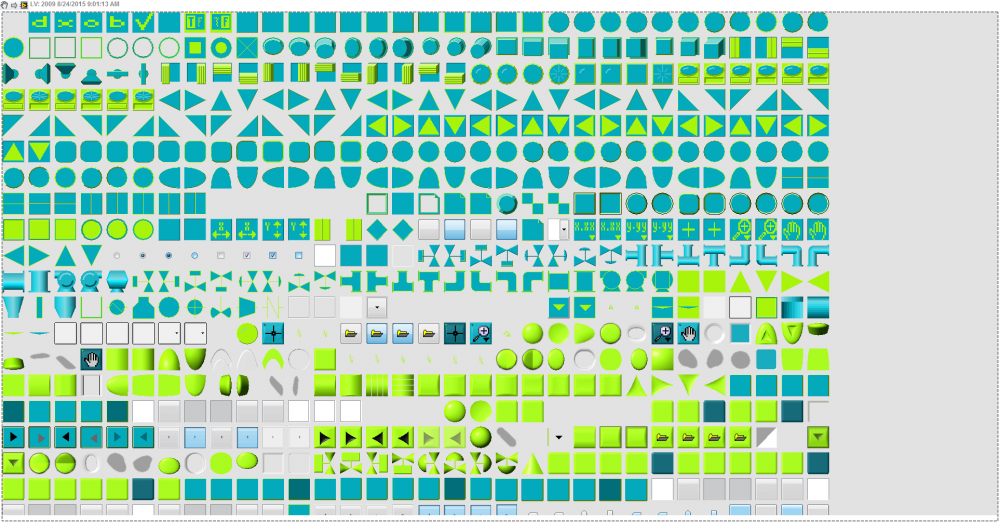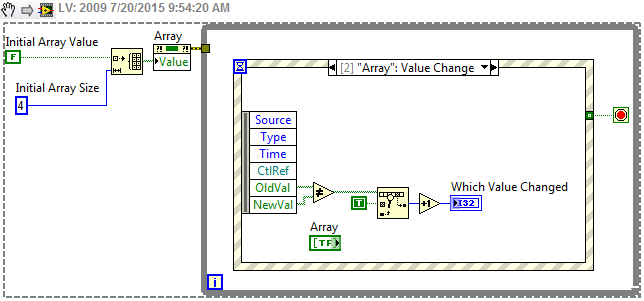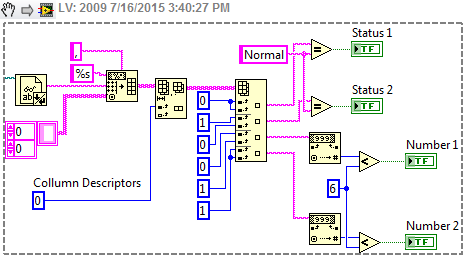
infinitenothing
Members-
Posts
372 -
Joined
-
Last visited
-
Days Won
16
Content Type
Profiles
Forums
Downloads
Gallery
Everything posted by infinitenothing
-
Keep Windows up to date Install antivirus Windows is logged in as normal user, not admin Firewall off everything you don't need Use a VPN to get into local networks If I had to expose a service I'd use HTTPS
-
It's been a while since I've used Vision but I remember seeing some weird things with the higher bit depth images. I remember that sometimes you had to explicitly set the bit depth of the image: http://zone.ni.com/reference/en-XX/help/370281P-01/imaqvision/imaq_image_bit_depth/ What pixel values are in your image? Could they just be really low? I'm guessing the gradient or rainbow pallets aren't helping
-
Keeping track of licenses of OpenG components
infinitenothing replied to Mellroth's topic in OpenG General Discussions
You're not really an end user if the executable is being used by someone else. You're more like a middle user Can I suggest using a license that doesn't follow the binary, maybe Apache or MIT, for future work. -
Anyone tired of their myrio and looking to unload it? $1000 seems a little steep.
-
I'm not sure I've ever seen a port freeze on my dev computer but I know I've heard of freezes in the field. I tell them to call IT. The only timing issue I've had is with flush and what happened was that flush was clearing data from a prior visa write.. Are you using NI serial ports? I'm guessing that's going to be more reliable or at least give you a better outlet for troubleshooting. I open the port at the beginning and close at the end. That's never been a problem. I use both sync and async read/writes.
-
Most secure camera connection
infinitenothing replied to infinitenothing's topic in Machine Vision and Imaging
2048*48K= 983,040,000 pixels per second. Assuming 8 bit images You're at 7.9 Gb/s which is too fast for gige but in USB3.1 range. -
I remember many years ago, we'd have a camera in an inspection system and it would disappear or something and a reboot would fix it. Is this a thing ever anymore? Is there any best practice on what the best interface is for reliability. I'm thinking GigE is the way to go because of the locking connector. Any thoughts?
-
There may also be third party tools that do something similar https://lavag.org/topic/19124-deploying-labview-code-to-raspberry-pi/
-
Is your RMS at least better? Yeah, the symmetric errors do look like glitching. I wonder if the high input impedance is a possible contributor. You could throw a 1KOhm in parallel and see what that does. If that isn't enough add a 20nF cap in there.
-
It might be worthwhile to look at what your AI waveform looks like. Maybe you have an offset in there.
-
See an exe front panel in another exe front panel
infinitenothing replied to spaghetti_developer's topic in LabVIEW General
I know someone out there has a tool for handling window's window handles and you can make arbitrary EXEs a child window. I was hoping they'd chime in.- 5 replies
-
- exe
- front panel
-
(and 1 more)
Tagged with:
-
All LabVIEW "decoration" objects, image ID's 0 to -4096
infinitenothing replied to Sparkette's topic in User Interface
-
Your class type has the queue in it. Your accessors have to dequeue-modify-enqueue with a timeout as an input. You have to have a Create-Run-Destroy architecture.
-
I don't run into this issue much but back before we had DVRs, many people were using single element queues for the same purpose.
-
Channel Wires (Asynchronous Wires) Discussion
infinitenothing replied to AutoMeasure's topic in LabVIEW General
Let me poke a hole in that theory. Async wires aren't necessary for anything. The functionality already exists as shown in the Getting Started guide. -
Any cool new features of LabVIEW or toolkit?
infinitenothing replied to doradorachan's topic in LabVIEW General
It's one of those implicit features. You'd expect 2015 to open block diagrams from 2015. -
Any cool new features of LabVIEW or toolkit?
infinitenothing replied to doradorachan's topic in LabVIEW General
The important one is that you'll be able to open block diagrams from other people who are writing in 2015 without going back and asking for a down conversion -
Create array of manually added values
infinitenothing replied to Zer0's topic in Application Design & Architecture
Zer0, where do you initialize (write zeros to) the array? I'm guessing you have a race condition. Using a shift register will fix that race condition -
How would you redesign the LV error cluster?
infinitenothing replied to Stobber's topic in LabVIEW General
There have been some attempts: https://lavag.org/topic/5047-prototype-replacement-for-errorllb-second-attempt/ https://lavag.org/topic/10741-updating-the-labview-error-handling-core/ -
Create array of manually added values
infinitenothing replied to Zer0's topic in Application Design & Architecture
Every time you start the outer while loop, you're going to start with the same initialized array coming into the wire. If you want labview to remember something from one iteration to the next, you need to put a shift register on that loop. The inner while loop does nothing as far as I can tell and probably should be removed. -
Also, you have no wait in your loop. Check your processor use—It's probably at 100% (not a great idea) for one of your processors. Try ~100 ms. If you still want to give the array event a try, here's an example of an event that is triggered by the array value change.
-
How to program after inputting text/excel file
infinitenothing replied to pkeny's topic in Database and File IO
I'm not totally clear on what you are having trouble with. After you bring in a CSV, you have an array. You need do some sort of array manipulation and comparison operations to trigger actions. I've attached a trivial example of what you can do with a 2D string array If you want that data to affect something physical you need help with DAQmx Here's a test CSV: Status,Number Normal,5 Broken,8 -
Your VI is going to read the stop button (False) then invert that (True) make an array from that Sit at the edge of the event structure for a bit Lets say you press stop 2 ms into the event structure wait—you have an array of true waiting at the incoming edge of the event structure. That true is going to go into your "data array". The next iteration starts, the "true" at the stop control is read at the begging of the loop, you wait and execute the timeout event You can verify the above sequence if you are patient and set a really long timeout (~30 seconds) and turn on highlight execution In the picture, the shift register is just a way to make the first iteration different from all the others. On the first iteration, the timeout is 0. All other iterations have a timeout of -1. Most of us like trigger our actions based on events rather than letting the timeout lazily pick up changes as needed. To that end, you can create an event that will start executing as soon as your "data" array changes. Also, your DAQmx clear and stop are being performed in the wrong order. Follow the examples.
-
No, that example writes to many lines at the same time. Look at the channel input: Dev1/port0/line0:7. That means that the "channel" is 8 lines. The input being an array goes along with this. Writing all the lines at the same time should be more efficient that writing them individually.
-
Look at the example here: {LabVIEW Programs Folder}\examples\DAQmx\Digital Output\Digital - SW-Timed Output.vi One of the best things about DAQmx is there's so many good examples.




